Common mugwort

Common mugwort
Artemisia
Plant family
Daisy family (Asteraceae)
Season Overview
Propagating
Planting
Harvest
Harvest
J
F
M
A
M
J
J
A
S
O
N
D
1ST YEAR
FOLLOWING YEARS
Details
Light requirement
Sunny
Water requirement
Dry
Soil
Light (sandy)
Nutrient requirement
Low
Light germinator
Plant distance
70 cm
Row spacing
70 cm
Seeding depth
0Not specified
Instructions
Description
Mugwort is known both as an ornamental plant, but also as a medicinal and medicinal plant. It belongs to the daisy family (Asteraceae). In addition to the common mugwort, there are over 500 species of mugwort, including tarragon and wormwood, for example. Since the species are sometimes very similar, there is a risk of confusion. It is also considered a nitrogen indicator and grows wild. It is also very popular with insects. Its yellow, white or brown flowers bloom between July and September and cause allergies in some people. It is propagated by seeds or cuttings. Some species can be rampant. It grows up to 1.5 m/1.6 yd tall and is hardy. Perennial.
Origin:
Northern or Central Europe to Asia
Growing tips
Sowing seeds is possible in the fall or spring. Mugwort is a light germinator. Cuttings are often used with common mugwort for propagation in spring or late summer. Do not cut back to woody parts, as it will then partially stop sprouting. Its composition also keeps slugs away, but can prevent other plants from growing if it becomes overgrown. Leave the foliage on the plant or on the ground in winter; this provides frost protection. To use: Mugwort leaves harvested just before flowering are used in the form of tea for loss of appetite, stomach and intestinal complaints, as a sleep aid and for nervous disorders. Homeopathy uses globules of Artemisia vulgaris for cramps and worm infestation. It should be avoided during pregnancy, as it can induce premature labor. It is called "women's herb" because it is supposed to promote fertility. Fresh leaves of the medicinal plants can be put on blisters or on open wounds during walks. As an incense, Artemisia vulgaris is said to be relaxing and dream-inducing. (From my-beautiful-garden).
Antagonistic Plants
No antagonistic plants
Diseases
Root Rot
Downy mildew
Pests
Aphids